The first space suit. Vacuum Clothing: How Space Suits Work
Few people know that for the Soviet expedition to the moon, only one component was completely ready and tested - the Krechet space lunar suit. Even fewer people know how it works.
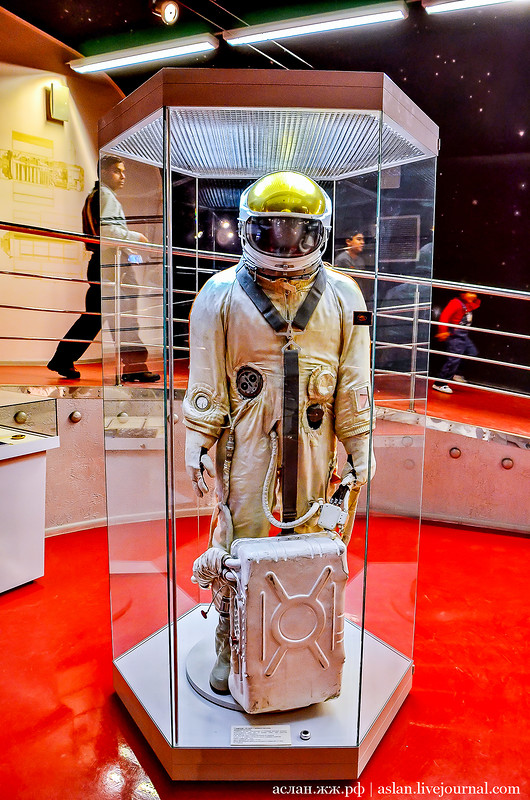
With the development of jet aviation, the problems of protecting and rescuing the crew during high-altitude flights seriously arose. As the pressure drops, it becomes more and more difficult for the human body to absorb oxygen, a common person without any problems, it can be at an altitude of no more than 4-5 km. At high altitudes, it is necessary to add oxygen to the inhaled air, and from 7–8 km a person should generally breathe pure oxygen. Above 12 km, the lungs completely lose the ability to absorb oxygen - pressure compensation is required to rise to a greater height.
To date, there are only two types of pressure compensation: mechanical and the creation of a gas environment around a person with excess pressure. A typical example of a solution of the first type are high-altitude compensation flight suits - for example, VKK-6, used by MiG-31 pilots. In the event of a cabin depressurization, such a suit creates pressure, squeezing the body mechanically. At the heart of such a costume is a rather witty idea. The pilot's body is entwined with ribbons resembling a figure eight.

A rubber chamber is passed through a smaller hole. In the event of depressurization, compressed air is supplied to the chamber, it increases in diameter, reducing, accordingly, the diameter of the ring entangling the pilot. However, this method of pressure compensation is extreme: a trained pilot in a compensating suit can spend no more than 20 minutes in a depressurized cockpit at an altitude. Yes, and it is impossible to create uniform pressure on the whole body with such a suit: some parts of the body turn out to be constricted, some are not squeezed at all.

Another thing is the space suit, which, in fact, is a sealed bag in which excess pressure is created. The time a person spends in a spacesuit is practically unlimited. But it also has its drawbacks - the restriction of the mobility of a pilot or astronaut. What is a spacesuit sleeve? In practice, this is an aerobulk in which excess pressure is created (in spacesuits, a pressure of 0.4 atmospheres is usually maintained, which corresponds to an altitude of 7 km). Try bending an inflated car camera. Is it difficult? Therefore, one of the most guarded secrets of the production of space suits is the technology for the production of special "soft" hinges. But first things first.
"Vorkuta"
The first space suits, before the war, were manufactured at the LII. Gromov, were created for research purposes and were used mainly for experimental flights in stratospheric balloons. After the war, interest in spacesuits resumed, and in 1952, in Tomilin, near Moscow, a special enterprise for the manufacture and development of such systems was opened - Plant No. 918, now NPP Zvezda. During the 50s, the enterprise developed a whole line of experimental spacesuits, but only one of them, Vorkuta, designed for the Su-9 interceptor, was produced in a small series.
Almost simultaneously with the release of Vorkuta, the enterprise was given the task of developing a space suit and rescue system for the first cosmonaut. Initially, the Korolyov design bureau issued the terms of reference to Zvezda for the development of a spacesuit completely closed to the ship's life support system. However, a year before Gagarin's flight, a new task was received - for an ordinary protective suit, designed to save the cosmonaut only when he ejected and splashed down.
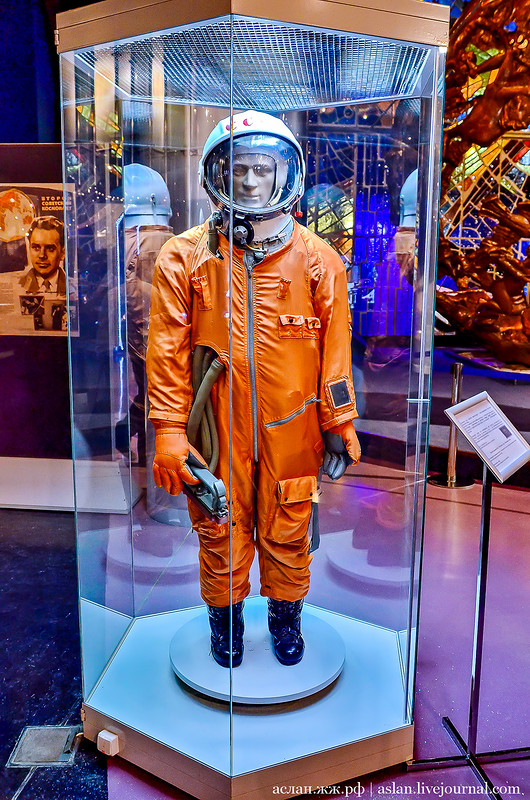
Opponents of spacesuits considered the probability of depressurization of the ship to be extremely small. Six months later, Korolev again changed his mind - this time in favor of spacesuits. Ready-made aviation suits were taken as a basis. There was no time left for docking with the onboard system of the ship, so an autonomous version of the life support system of the spacesuit was adopted, placed in the astronaut's ejection seat.

The shell for the first SK-1 space suit was largely borrowed from the Vorkuta, but the helmet was completely remade. The task was set extremely tough: the spacesuit had to save the astronaut without fail! No one knew how a person would behave during the first flight, so the life support system was built in such a way as to save the astronaut, even if he lost consciousness - many functions were automated. For example, a special mechanism was installed in the helmet, controlled by a pressure sensor. And if it fell sharply in the ship, a special mechanism instantly slammed the transparent visor shut, completely sealing the spacesuit.

in layers
Space suits consist of two main shells: internal sealed and external power. In the first Soviet spacesuits, the inner shell was made of sheet rubber by elementary gluing. Rubber, however, was special; high-quality natural rubber was used for its production. Starting with the Sokol rescue suits, the hermetic shell has become rubber-fabric, but in spacesuits designed for spacewalks, an alternative to sheet rubber is not yet foreseen.
"Lunar" suit of astronauts - participants of the Apollo missions. 
The outer shell is fabric. The Americans use nylon for it, we use the domestic analogue, capron. It protects the rubber shell from damage and keeps its shape. It is difficult to come up with a better analogy than a soccer ball: a leather outer cover protects the inner rubber chamber from football boots and ensures that the geometric dimensions of the ball remain unchanged.
No person can spend a long time in a rubber bag (whoever has army experience in forced marches in a rubberized combined-arms protective kit will understand this especially well). Therefore, each spacesuit must have a ventilation system: conditioned air is supplied to the entire body through one channel, and it is sucked out through others.
According to the method of operation of the life support system, spacesuits are divided into two types - ventilation and regeneration. In the first, simpler in design, the used air is thrown out, similar to modern scuba gear. According to this principle, the first spacesuits SK-1, Leonov's spacesuit for spacewalks "Berkut" and light rescue suits "Sokol" were arranged.
Thermos
For a long stay in space and on the surface of the Moon, regeneration long-stay spacesuits were required - "Orlan" and "Krechet". In them, the exhaled gas is regenerated, moisture is taken from it, the air is saturated with oxygen and cooled. In fact, such a suit in miniature copies the life support system of an entire spacecraft. Under the spacesuit, the cosmonaut puts on a special water-cooled mesh suit, all pierced by plastic tubes with coolant. Heating problems in exit suits (designed for spacewalks) have never arisen, even if the astronaut worked in the shade, where the temperature drops rapidly to -100C.

The matter is that the external overalls ideally carry out functions of heat-protective clothes. For this, for the first time, screen-vacuum insulation was used, which works on the principle of a thermos. Under the outer protective shell of the overalls there are five or six layers of a special film made of special polyethylene, teriphthalate, on both sides of which aluminum is sprayed. In a vacuum, heat transfer between film layers is possible only due to radiation, which is rereflected back by a mirror-like aluminum surface. External heat transfer in vacuum in such a suit is so small that it is considered equal to zero, and only internal heat transfer is taken into account in the calculation.
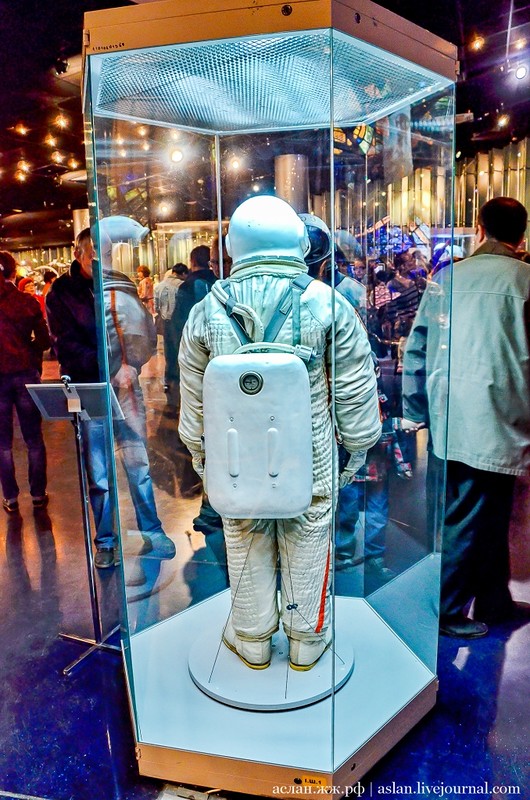

For the first time, screen-vacuum thermal protection was used on the Berkut, in which Leonov went into outer space. However, under the first rescue suits that did not work in a vacuum, a TVK (thermal protective ventilated suit) was worn, made of warm quilted material, in which the ventilation lines were laid. This is not the case in modern Sokol rescue suits.

In addition to all this, the astronauts are put on cotton underwear with special antibacterial impregnation, under which the last element is located - a special bib with telemetric sensors attached to it, transmitting information about the state of the astronaut's body.
Sokolyata
Spacesuits were not always on ships. After six successful flights of the Vostoks, they were recognized as useless cargo, and all further ships (Voskhods and Soyuz) were designed to fly without regular spacesuits. It was expedient to use only external suits for spacewalks. However, the death in 1971 of Dobrovolsky, Volkov and Patsaev as a result of the depressurization of the Soyuz-11 cabin forced us to return to a proven solution. However, the old spacesuits did not fit into the new ship. As a matter of urgency, the Sokol light space suit, originally developed for the T-4 supersonic strategic bomber, began to be adapted to space needs.
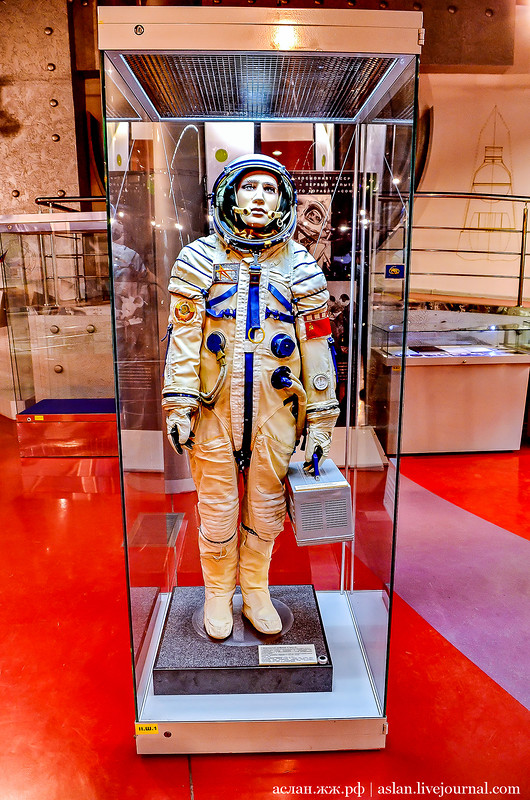
The task was not an easy one. If the cosmonaut ejected during the landing of the Vostoks, then the Voskhods and Soyuzs carried out a soft landing with the crew inside. It was only relatively soft - the impact upon landing was palpable. The impact was amortized by the energy-absorbing Kazbek chair developed by the same Zvezda. Kazbek was molded individually for each astronaut who lay in it without a single gap. Therefore, the ring, to which the spacesuit helmet is attached, would certainly break the cosmonaut's cervical vertebra upon impact.

In the Sokol, an original solution was found - a sector helmet that does not cover the back of the spacesuit, which is made soft. A number of emergency systems and a heat-shielding layer were also removed from the Sokol, since in the event of a splashdown when leaving the Soyuz, the astronauts had to change into special suits. The life support system of the suit was also greatly simplified, designed for only two hours of work.

As a result, the Sokol became a bestseller: since 1973, more than 280 of them have been manufactured. In the early 90s, two Sokols were sold to China, and the first Chinese cosmonaut flew to conquer space in an exact copy of the Russian spacesuit. True, unlicensed. But no one sold spacesuits for outer space to the Chinese, so they are not even planning a spacewalk yet.
Cuirassiers
In order to facilitate the design and increase the mobility of external suits, there was a whole trend (primarily in the USA), which studied the possibility of creating all-metal rigid suits resembling deep-sea diving suits. However, the idea was partially implemented only in the USSR. Soviet spacesuits "Krechet" and "Orlan" received a combined shell - a rigid body and soft legs and arms. The hull itself, which the designers call a cuirass, is welded from individual elements made of aluminum alloy of the AMG type. Such a combined scheme turned out to be extremely successful and is now being copied by the Americans. And it came out of necessity.
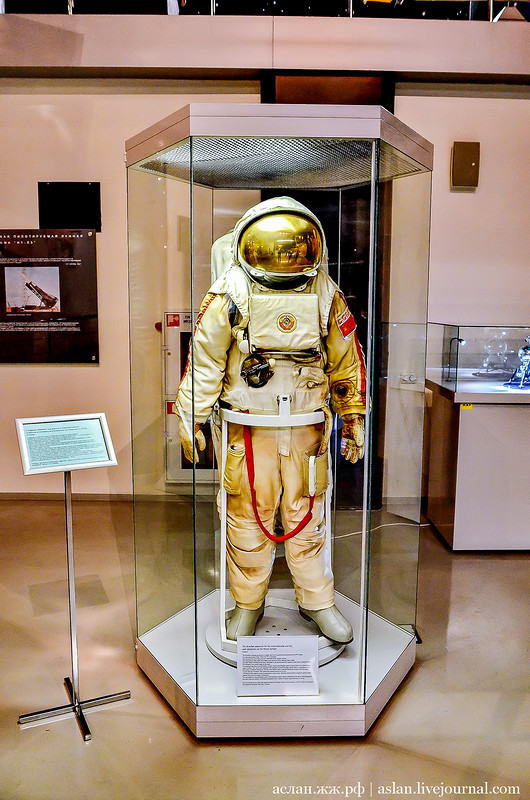
The American lunar spacesuit was made according to the classical scheme. The entire life support system was located in an unpressurized satchel on the astronaut's back. Soviet designers might also have followed this pattern, if not for one "but". The power of the Soviet moon rocket The H-1 made it possible to deliver only one cosmonaut to the Moon, unlike two American ones, and it was not possible to dress alone in a classic spacesuit. Therefore, the idea of a rigid cuirass with a door on the back to enter inside was put forward.
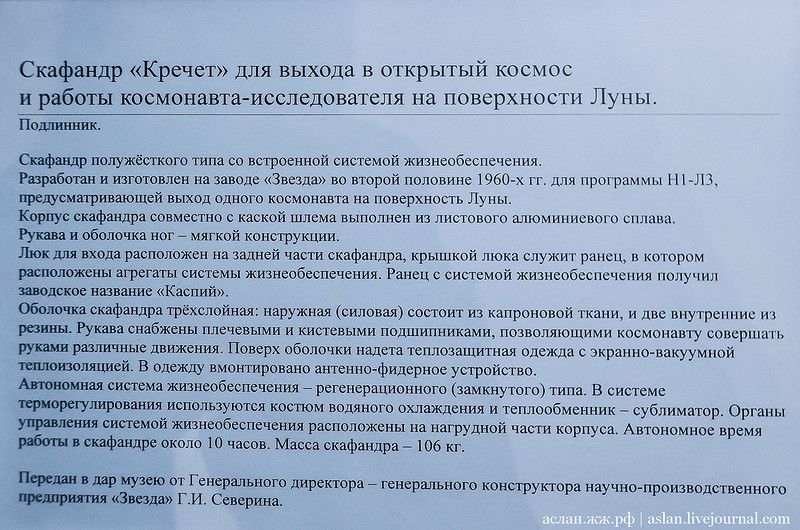
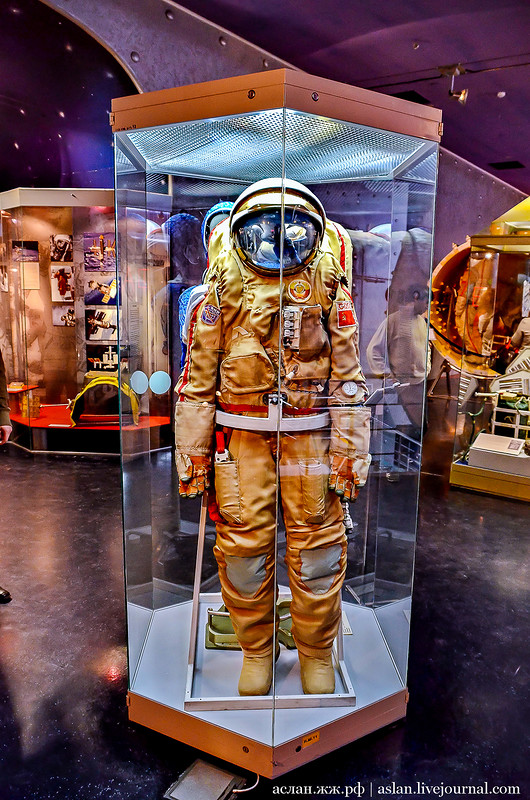
A special system of cables and a side lever made it possible to securely close the lid behind them. The entire life support system was located in a hinged door and did not work in a vacuum, like the Americans, but in a normal atmosphere, which simplified the design. True, the helmet had to be made not swivel, as in early models, but monolithic with a body. The review was compensated by a much larger glass area. The helmets themselves in space suits are so interesting that they deserve a separate chapter.
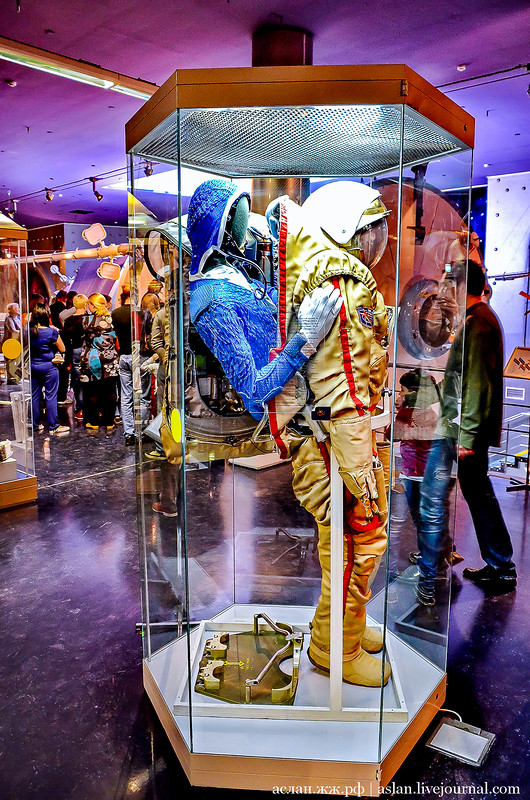
Helmet around the head
The helmet is the most important part of the suit. Even in the "aviation" period, spacesuits were divided into two types - masked and maskless. In the first, the pilot used an oxygen mask, through which an air mixture was supplied for breathing. In the second, the helmet was separated from the rest of the spacesuit by a kind of collar, a hermetic neck curtain. Such a helmet played the role of a large oxygen mask with a continuous supply of breathing mixture. As a result, the maskless concept won, which provided better ergonomics, although it required more oxygen for breathing. Such helmets migrated into space.
Space helmets were also divided into two types - removable and non-removable. The first SK-1 was equipped with a non-removable helmet, but the Leonov "Berkut" and "Hawk" (in which Eliseev and Khrunov moved from ship to ship in 1969) had removable helmets. Moreover, they were connected with a special hermetic connector with a hermetic bearing, which made it possible for the astronaut to turn his head. The turning mechanism was quite interesting.
The newsreel footage clearly shows the astronauts' helmets, which are made of fabric and thin leather. They are equipped with communication systems - headphones and microphones. So, the convex earpieces of the headset were included in the special grooves of the hard helmet, and when the head was turned, the helmet began to rotate along with the head, like a tank turret. The design was rather cumbersome, and it was later abandoned. On the modern space suits helmets are not removable.
An obligatory element of a helmet for going into space is a light filter. Leonov had a small airplane-type internal light filter coated with a thin layer of silver. When leaving for space, Leonov felt a very intense heating of the lower part of his face, and when looking towards the Sun, the protective properties of the silver light filter turned out to be insufficient - the light was dazzlingly bright. Based on this experience, all subsequent spacesuits began to be equipped with full external light filters with a rather thick layer of pure gold deposited, which ensures the transmission of only 34% of the light. Orlan has the largest glazing area.
Moreover, on the latest models there is even a special window on top - to improve visibility. It is almost impossible to break the "glass" of the helmet: it is made of heavy-duty Lexan polycarbonate, which is also used, for example, in the glazing of armored cockpits of combat helicopters. However, the Orlan costs like two combat helicopters. The exact price is not called, but they suggest focusing on the cost of the American counterpart - $ 12 million.
0Astronaut clothing
AT Everyday life the purpose of clothing is to reduce body heat loss, provide optimal conditions for maintaining a constant body temperature, and also protect against adverse effects external environment(high and low temperature, rain, snow, wind, dust). In the cockpit of a spacecraft, where these factors are either absent or reduced to a minimum, clothing acquires somewhat different functions.
The widespread division of cosmonauts' clothing into proper clothing and space suits is largely arbitrary, because, in essence, space suits in the specific conditions of cosmonauts' activities (including during spacewalks or on the surface of a particular planet) perform all the functions of clothing adapted to a specific production activity.
Like earthly clothing, cosmonauts' clothing should be comfortable for work and leisure, and not impede or restrict movement. The well-known position that the best clothes are those that we do not feel is quite applicable in this case.
The astronauts' clothing set consists of underwear, a flight suit in which the astronauts are in the spacecraft, and a heat-protective suit.
Underwear and flight suits are designed for everyday wear and can be used once or repeatedly.
Disposable clothing is intended to be worn for a certain period of time, after which it enters the waste disposal system or, if it is provided for by the research program, is packed in hermetic containers (bags) and stored until the end of the flight, and the astronauts put on a new set.
Reusable clothing is worn for the same or slightly shorter period of time as disposable clothing, but then not destroyed, but subjected to one or another type of cleaning.
Both ways of using clothes have their advantages and disadvantages. The use of disposable clothing, without requiring special cleaning devices, simplifies the design of spacecraft household equipment. However, with an increase in the number of crew and a significant duration of the flight, the volume and weight of the change of clothes can reach very large values.
So, according to United Aircraft, for a flight of a crew of three over 200 days and a change of clothes every 10 days, the weight of disposable clothing will significantly exceed all allowable limits.
The use of reusable clothing, with all its visible advantages in this moment cannot be implemented due to the lack of appropriate washing and drying facilities.
Available data indicate that such installations will not be established in the near future. Therefore, in most of the currently planned space flights, astronauts will apparently use disposable clothing.
Thermal protective suits should also be referred to single-use clothing. These suits are used when landing in a deserted area in adverse climatic conditions. In addition, they can be used in the event of a malfunction of the air conditioning systems on board the spacecraft.
Let us now dwell in more detail on the features of the astronauts' clothing.
Underwear
Underwear is in direct contact with the skin. This determines the main requirement for this species clothing - do not irritate the skin. The fabric of underwear should be light, elastic and not impede heat transfer by convection and radiation, and also not interfere with the evaporation of moisture from the surface of the body.
It is necessary that the fabric from which the astronauts' underwear is made has sufficient strength for long-term wear and for attaching sensors to it to collect biotelemetric information. Washing and various types of sterilization should not change the properties of the fabric.
The high hygienic properties of natural linen and cotton fabrics first of all attracted the attention of the creators of astronaut clothing. Yes, for crews spaceships type "Apollo" underwear was made of porous cotton fabric knitted type. Studies have shown its high breathability, moisture capacity and ability to absorb chlorides and organic substances from the skin. In the future, to increase wear resistance, it was considered expedient to use linen and cotton fibers not in their pure form, but in a mixture with other, more durable components. This was of particular importance for underwear worn under a spacesuit.
An important role in the creation of underwear is played by the structure of the fabric. The need to ensure maximum compatibility of underwear with the next layer of clothing (flight suit or space suit) and, therefore, to exclude the possibility of wrinkles on the underwear, as well as the desire to minimize the number of seams, led to the idea of using knitted fabric. Knitwear allows you to make underwear that evenly fits the body without excessive folds.
As a result of physiological-hygienic and physico-chemical studies of various knitted fabrics for cosmonauts' underwear, cotton-viscose knitwear made on small-scale machines was recommended. This jersey has high breathability (not less than 400/600 l/m 2 * sec at a pressure of 5 mm water column) and vapor permeability with a resistance of about 1 mm of the air layer. The hygroscopicity of this laundry fabric is not less than 7% at relative humidity air 60%. The strength of knitwear is quite high - at least 20 kg for a strip width of 50 mm. The thickness of the web at a load of 10 g is 0.73 mm.
Underwear made of such jersey does not complicate putting on a space suit and does not cause discomfort when wearing it under a space suit for 10 days. It is well blown and provides sufficient aeration of the skin surface during the operation of the ventilation system of the suit. The developed design of underwear, including a jersey, seamless socks and underpants with a special crotch flap that allows the use of a sewage device, was successfully used by astronauts of the Vostok-type spacecraft and can be recommended for use as clothing worn under a space suit.
The limited possibilities for carrying out hygienic measures to cleanse the body during space flight have led to the use of the sorption properties of underwear fabrics for these purposes. It is known that with sufficient wicking of the fabric from which the underwear is made, it can absorb a certain amount of skin secretions. With the increase in the duration of space flights, this ability of underwear fabrics is becoming increasingly important.
Speaking about the sorption properties of linen, one more very important aspect of this issue should be noted - the transfer of a part of the microflora from the body surface to the linen. In the further presentation, the dependence between the properties of linen, the volume and frequency of hygienic treatment of the skin and the amount and types of microflora on it will be shown in detail.
It can be assumed that as the duration of space flights increases, the problem of reducing the microbial contamination of the skin will become increasingly important. One of the promising ways to reduce the microbial contamination of the skin and underwear is the use of antimicrobial textile materials. Methods for obtaining such materials last years much attention is given.
More recently, tissue impregnation with various bactericidal (bacteriostatic) preparations has been used. However, the insufficient stability of these preparations during washing and during the operation of fabrics required further research. The search for the possibility of attaching bactericidal preparations directly to the macromolecules of fiber-forming polymers gave the greatest results when using polyvinyl alcohol and cellulose fibers.
Underwear made from Letilan fiber with the introduction of a 5-nitrofuran preparation has a pronounced antimicrobial effect on the microflora that usually vegetates on the surface of human skin.
Another method for producing antimicrobial chemical fibers is to introduce drugs that are insoluble or poorly soluble in water into the spinning solution of polymers during fiber formation.
When testing antimicrobial underwear for 10-15 days under conditions ordinary life no negative changes in the functional state of the skin were found.
It should be noted that the complexity of creating antimicrobial linen is due not only to the difficulties in selecting combinations of bactericidal (bacteriostatic) drugs and the corresponding chemical fibers, but also to the possibility of various kinds of dysbacteriosis due to the use of such linen.
The data currently available make the prospect of using antimicrobial underwear for long-duration spacecraft very attractive.
flight suit
Depending on the program and specific flight conditions, the cosmonauts' outerwear is either a flight suit or a space suit.
The design of the flight suit must not restrict freedom and range of motion and thus not affect the cosmonaut's performance, provide for the possibility of using a sewage device, and allow for its quick putting on and taking off.
The flight suit must be fully compatible with underwear and a thermal protective suit. The heat-shielding properties of a flight suit must be optimal for a given temperature regime of the ship's cabin. When developing a flight suit, it is necessary to provide for the possibility of attaching sensors for collecting biotelemetric information, as well as several pockets for small personal items.
The fabric used for the manufacture of a flight suit must be light, soft, elastic, wear-resistant, flame-retardant and must not contribute to the release of dust, and tension electrostatic field this tissue should not exceed a certain value.
If a flight suit is intended to be used multiple times, it is essential that the fabric retains its properties after washing and various kinds sterilization. In all cases, the fabric and design of the suit should not impede heat transfer by convection, radiation, and evaporation of moisture from the body surface.
In long-term space flights, the color and intensity of coloring of outer clothing fabrics acquire a certain significance. Based on the requirements of hygiene and technical
aesthetics, preference is given to clothes of light calm tones. When choosing the color of the suits, the individual tastes of the crew members should also be taken into account.
Naturally, when designing flight suits, it is necessary to select fabrics with high wear resistance and strength. As well as in the design of underwear, the possibility of using synthetic fibers was studied.
Synthetic fabrics for the most part are characterized by high strength, elasticity, crease resistance, and are easy to mechanically clean.
To date, many slow-burning, fire-resistant synthetic fabrics have been created that do not support combustion when the temperature rises.
At the same time, the use of polymeric synthetic materials is fraught with the potential for the release of volatile harmful substances from them into the air. This can be caused by the presence in the materials of a residual amount of free monomers that did not enter into the polymerization or polycondensation reaction, which, as a rule, have toxic properties. The release of monomers and particles with low molecular weight can also be a consequence of degradation processes.
It should be noted that there electrostatic charges in synthetic materials. Thus, large charges were found in products made of chlorine and acetate silk, in shoes made using polymeric materials. In some cases, the long-term electrostatic field strength reaches 6-8 kV/cm 2 and is accompanied by unpleasant and even painful sensations in a person wearing such clothes. No negative phenomena are found only at an electrostatic field strength not exceeding 200-400 V/cm 2 . The presence of an electrostatic field contributes to more rapid contamination of clothing.
Significant disadvantages of synthetic fabrics in comparison with natural ones are their lower hygroscopicity, vapor permeability and thermal resistance. Studies have shown that the hygroscopicity of lavsan is 16 times, and nitrone 4 times less than that of Boston woolen fabric.
In addition, it was found that as the proportion of synthetic fiber in the fabric increases, its hygienic properties deteriorate, and these changes are linear; a decrease in the hygienic properties of a fabric containing synthetic fiber up to 50% does not significantly affect the general physiological and hygienic properties of clothing made from it; clothes made of mixed fabric can be recommended for use at an ambient temperature of +18/+50°C.
When choosing a synthetic fiber for mixed yarn, it seems most appropriate to use polyester fiber lavsan, which has a high heat-shielding ability and strength, elasticity, crease resistance, thermal and chemical stability, abrasion resistance, resistance to sunlight, chemical agents, bacteria. etc.
One of the main tasks in the design of flight clothing is the preservation heat balance in astronauts, i.e., preventing both excessive heat transfer by the body and the accumulation of excess heat. A person dressed in ordinary two-layer clothing maintains thermal balance at certain combinations of heat production and ambient temperatures.
We provide information about the character physical work required to maintain the thermal balance of a person dressed in two-layer clothing, with different temperature ambient air:
In order to determine the heat-shielding properties of clothing for a person who is in relative rest, at a low air speed, one can roughly be guided by the data of Winslow et al.:

It is known that the specified microclimate regime in spacecraft cabins corresponds to comfortable values: air temperature 18/23°C, air velocity 0.05/0.5 m/s; relative humidity 40-65%.
Taking into account that during the flight the cosmonauts are mostly at rest or perform light physical work, their everyday clothing should have a thermal insulation of the order of 1-1.2 Klo.
When the air temperature in the cabin rises above the calculated values, the cosmonauts are recommended to take off their flight suit jacket or remain only in their underwear to maintain comfortable heat sensations. When the air temperature drops below 18 ° C, thermal comfort can be achieved through the use of a heat-protective suit (it is worn over a flight suit), woolen socks and a woolen cap or helmet.
Thermal suit
As already mentioned, the main purpose of a heat-protective suit is to provide thermal comfort for astronauts when the temperature in the spacecraft cabin drops (as a rule, in the event of an emergency), as well as when leaving the spacecraft after landing (splashdown). Not being everyday clothing for astronauts, the heat-protective suit must be stored in conditions that ensure its rapid use if necessary. The general requirements for the design of such a suit and the composition of its fabrics coincide with the requirements for pilots' suits.
When creating heat-protective clothing, the rational use of individual layers of material is of great importance. When designing the structure of a package of thermal protective clothing, it is advisable that the functions of its individual layers be strictly specialized. A winter clothing package usually consists of an outer fabric, a windscreen, an insulation pad and a lining. Integumentary tissues perceive mechanical impacts when using clothes and determine its appearance.
The main requirements that cover fabrics must satisfy are wear resistance, strength, crease resistance, resistance to impact. environment(light, precipitation).
The purpose of the windproof pad is to create a low air permeability of the package, which maintains a high level of heat-shielding properties of clothing when it is used in wind conditions. It is necessary that windscreens have the following main properties: air tightness within 7/40 l/m 2 * sec (depending on meteorological conditions), light weight, minimal rigidity, sufficient strength and vapor permeability.
Insulating pads provide heat-shielding properties of clothing.
They are subject to the following requirements: layer stability and resistance to mechanical stress during operation, low volumetric weight, sufficiently high air and vapor permeability. The lining should be light, durable, wear-resistant, have a smooth surface.
The vapor permeability of the package of materials cannot be less than 25 g/m 2 * hour.
Of course, a different design of the heat-protective suit is possible. So, for example, the cover fabric of a suit can simultaneously serve as an insulating pad. It is only important that the heat-protective suit has the necessary thermal insulation.
Apparently, the thermal insulation of flight thermal protective suits should be at least 2 KLO, which corresponds to the thermal insulation of clothing for transitional and winter seasons. We give information about the thermal insulation of the main types of clothing.

As can be seen from the given data, for winter and arctic types of clothing, thermal insulation of 3 / 6 KLO is required. Ideal thermal clothing can provide no more than 1.6 KLO of thermal protection per 1 cm of its thickness. However, it is very difficult to obtain this value in practice. Thermal protective clothing with the indicated indicators is provided with a layer thickness above 3-4 cm, which greatly complicates the movement of a person. Therefore, it is advisable to limit the heat-shielding properties of flight clothing to a value of thermal insulation of 3-4 KLO.
It is known that such constructive factors as the curvature of the heat-shielding layer of clothing and the presence of air between the layers of fabrics also have a significant impact on the heat-shielding properties of clothing. By using the heat-insulating properties of "inert air", it is possible to significantly increase the heat-shielding properties of clothing. By changing the material of the fabric, the heat-shielding properties of clothing can be maximized by only 16%. All this testifies to great importance constructive solutions in the creation of in-flight heat-protective clothing.
Table 1. Dependence of the thermal insulation of clothing (in CLO) on the level of physical work at an air speed of 0.5 m / s and total radiation up to 0.5 kcal / cm 2 * min
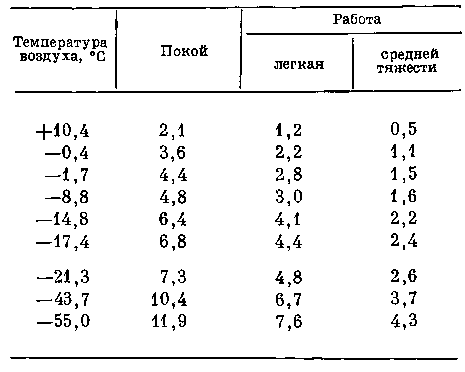
When designing such suits, it is also necessary to take into account the amount of physical work and the movement of the surrounding air, since these factors have a great influence on the level of thermal insulation of clothing (Table 1).
Shoes and headwear
The kit, along with flight and heat-protective suits, includes shoes and a headgear.
Hats made from the same fabrics as the suit itself can be used with flight suits. The cap should be sewn from fabrics that are sufficiently light, soft, elastic and do not irritate the scalp.
The design of the cap should be easy to use and not impede heat transfer by convection, radiation and moisture evaporation. A very comfortable sports cap with a visor and a folding side.
With a heat-protective suit, it is rational to use helmets that are put on a cap and attached to it with special devices. Helmets may be non-removable, being integral part suit, and removable. In the latter case, the helmet goes into a cape, which allows you to insulate the chest, back and shoulders. In addition, it should fit the head well and have sufficient thermal insulation. The design of the helmet provides for the possibility of attaching sensors to it to remove biotelemetric information and intercoms of the communication system.
Included with the heat-protective suit is footwear, which should be light, durable, and have good thermal insulation properties. This is ensured by an appropriate selection of materials and a design designed also for the stay of an astronaut in weightless conditions.
Download abstract: You do not have access to download files from our server.
April 12, 2010 marks exactly 49 years since the first space flight by Yuri Gagarin in 1961. On this day, the whole planet celebrates the world day of aviation and astronautics.
On this occasion, I decided to write a post about space suits - to tell about the history of their occurrence, design and, if possible, compare our space suits with American counterparts.
A bit of pre-cosmic history
The need to create a spacesuit appeared in the early 30s. The fact is that test pilots, even in oxygen helmets, could not climb to altitudes of more than 12 km due to reduced atmospheric pressure. At this height, nitrogen dissolved in human tissues begins to turn into gaseous state, which results in pain.
Therefore, in 1931, engineer E. Chertovsky designed the first Ch-1 spacesuit. It was a simple sealed suit with a helmet equipped with a small glass for viewing. In general, in "Ch-1" one could do anything, but not work. However, it was a breakthrough nonetheless. Later, before the war, Chertovsky managed to design six more models of spacesuits.
After the war, the first jet fighters, which sharply raised the bar of maximum heights. In 1947-1950, a group of designers led by A. Boyko created the first post-war air suits, called VSS-01 and VSS-04 (high-altitude rescue suit). They were airtight overalls made of rubberized fabric, to which non-removable folding helmets and oxygen masks were attached. Excess pressure at altitude was released by a special valve.
Start of development
In general, the development of spacesuits at first did not develop very well for us. The fact is that the existing developments of spacesuits were useless in the event of depressurization of the ship in space. And the designers have nothing to do with it - they were simply given the task of developing a protective suit designed to save the astronaut only after landing or splashing down the descent module. Among the opponents of the suits were even some of the designers of the ship - they considered the possibility of depressurization negligible. Their words were confirmed by the successful flight of Laika in the GZhK (hermetic cabin for animals)
Disputes were stopped only after the personal intervention of the Queen. At the same time, only 8 months remained before Gagarin's flight. During this time, the SK-1 spacesuit was created
There are 3 classes of suits in total:
Rescue suits - serve to protect astronauts in case of depressurization of the cabin or in case of significant deviations of the parameters of its gaseous medium from the norm;
suits for work in open space on the surface of the spacecraft or near it
suits for work on the surface of celestial bodies
The SK-1 was a first class suit. It was used during all flights of the ships of the first series "Vostok"
The SK-1 "worked" in tandem with a special heat-protective overall, which was put on by the cosmonaut under the main protective suit. The overalls were not just clothes, it was a whole engineering structure with ventilation system pipelines built into it, which maintained the necessary thermal regime of the body and removed moisture from the products of respiration. In unforeseen conditions, the life support system of the spacesuit (LSS) together with the LSS of the cabin "extended" the existence of the astronaut for 10 days. In the event of a depressurization of the cabin, the transparent "visor" - the helmet's porthole - was automatically closed and the air supply from the ship's cylinders was turned on.
But he had a significant drawback. Its soft shell, under the action of internal overpressure, always tends to take the form of a body of revolution and straighten up. It is not so easy to bend any part of it, say, a sleeve or a trouser leg, and the greater the internal pressure, the more difficult it is to do it. When working in the first space suits, due to their relatively low mobility, the astronauts had to expend considerable additional effort, which ultimately led to an increase in the intensity of metabolic processes in the body. Because of this, in turn, it was necessary to increase the mass and dimensions of the oxygen reserves, as well as the blocks of the cooling system.
The spacesuit SK-2 was also created. In fact, this is the same SK-1, only for women. It had a slightly different shape, taking into account their physiological characteristics.
analogue
The American counterpart to our SK-1 was the space suit for the Mercury spacecraft. It was also exclusively a rescue suit and was made in 1961.
In addition to everything, he had a metallized outer layer to reflect heat rays.
Golden eagle
In mid-1964, the leaders of the Soviet space program decided on a new experiment in orbit - the first exit of a man from a spacecraft into outer space. This circumstance posed a number of new technical challenges for spacesuit developers. They, of course, were dictated by serious differences between the internal environment of the spacecraft and the conditions of outer space - the realm of almost complete vacuum, harmful radiation and extreme temperatures.
The developers had two main tasks:
Firstly, a space suit for going into space had to protect against overheating if the astronaut was on the sunny side, and, conversely, from cooling if in the shade (the temperature difference between them is more than 100 ° C). It also had to protect from solar radiation and from meteoric matter.
Secondly, to ensure maximum safety for a person, to be extremely reliable and to have a minimum volume and mass. But the most important thing is that with all this, the astronaut in it must be able to work, i.e. move around the ship, perform certain work, etc.
All these requirements were implemented in the Berkut suit.
By the way, starting with the Berkut, all our spacesuits began to be called bird names.
The suit was made of several layers of film with a shiny aluminum surface. The place between the layers had a special gap in order to reduce the transfer of heat in any direction. The principle of a thermos is that no heat is taken in or given off. In addition, the layers of film-fabric are separated by a special mesh material. As a result, very high level thermal resistance. The astronaut's eyes were protected by a special light filter made of tinted organic glass almost half a centimeter thick. He played a dual role - weakened the intensity of sunlight and did not let the biologically dangerous part of the rays of the solar spectrum pass to the face.
The first spacewalk had limited missions. Therefore, the life support system seemed relatively simple and was designed for 45 minutes of work. She was placed in a knapsack with an oxygen device and cylinders with a capacity of 2 liters. A fitting for filling them and a pressure gauge window were attached to the body of the knapsack to control the pressure. Air was taken from the ship, which was additionally enriched with oxygen and entered the spacesuit. The same air carried away the heat, moisture, carbon dioxide, and harmful impurities released by the astronaut. Such a system is called an open system.
The whole system fit in a backpack measuring 520x320x120 mm, which was fastened to the back with a quick connector. In case of an emergency, a reserve oxygen system was installed in the lock chamber, which was connected to the spacesuit with a hose.
analogue
The analogue for the golden eagle was the spacesuit for the ships "Geminai"
His ship's version (I don't know what else to call it) was an ordinary rescue suit. A modified version was designed to work outside the spacecraft.
To do this, shells of thermal and micrometeorite protection were added to the main suit.
Hawk
Since 1967, flights of new Soyuz-type ships began, the fundamental difference of which from their predecessors was that they were already manned aircraft. And, consequently, the potential time of work of a person and space outside the ship should have increased. Accordingly, it was impossible to be in a spacesuit all the time. He was put on only in the most crucial moments - takeoff, landing. In addition, the question arose of launching into orbit several ships, their docking, which involved carrying out operations related to the passage of people through outer space.
For these purposes, a new spacesuit was developed with new system life support. They named him "Hawk"
This suit was basically similar to the Berkut, but the differences were in a different breathing system, which belonged to the so-called regeneration type. The breathing mixture circulated inside the suit along a closed circuit, where it was purified from carbon dioxide, harmful impurities, fed with oxygen and cooled. Oxygen cylinders also remained part of the system, but the oxygen contained in them was used only to compensate for leaks and for the astronaut's consumption. For this system, several unique units had to be created at once: an evaporative heat exchanger operating in specific conditions of weightlessness; carbon dioxide absorber; an electric motor that operates safely in a pure oxygen atmosphere and creates the necessary air circulation inside the spacesuit, and others.
Air cooling was used to cool the astronaut's body. To do this, it is necessary to drive a very large volume of gas through the suit. This, in turn, requires a fan with a power of several hundred watts, as well as a large amount of electricity. And strong airflow is not very pleasant for an astronaut.
A notable advantage was that the mass of the suit does not exceed 8-10 kg, and the thickness of the shell package is minimal. This makes it possible to use it with the individual texture of shock-absorbing seats, which weaken the effect of overloads during launch into orbit and descent.
In practice, the Hawk was used only once - to transfer from Soyuz-5 to Soyuz-4.
analogue
I did not find a specific American analogue of the "Hawk". Partly, a spacesuit for the early Apollos seems to fit under it.
Merlin
For the flight to the moon, an innovative spacesuit of the 3rd category was being built. In a spacesuit, the cosmonaut had to retain such motor and working abilities, which on earth are considered elementary. For example, to move on the lunar surface, taking into account the fact that "walks" can take place on a different terrain; to be able to stand up in case of a fall, to make contact with the lunar "earth", the temperature of which fluctuates over a very wide range (in the shade and in the light from -130 ° C to + 160 ° C); work with instruments, collect samples of lunar rocks and perform primitive drilling. The astronaut had to be provided with the opportunity to refresh himself with special liquid food, as well as to remove urine from the spacesuit. In a word, the entire life support system was designed for more difficult working conditions than those that existed during the orbital exits of the researchers.
Taking into account these requirements, under the leadership of A. Stoklitsky, the Krechet spacesuit was created
He had a so-called "semi-rigid" shell, and instead of a knapsack - a built-in life support system. It was from him that the phrase "enter the spacesuit" went. Because the cosmonaut entered the "Krechet" using the "door" on his back. The “door” housed all life support systems
The Krechet systems provided a record autonomous stay of a person on the Moon - up to 10 hours, during which the researcher could perform work with heavy physical exertion. For thermal cooling, a water-cooled suit was used for the first time, because. water cooling is the only possible method of maintaining acceptable thermal conditions in a spacesuit during intensive work of an astronaut. To remove 300-500 kcal / h of heat, the water flow through the water cooling suit was 1.5-2 l / min, the required length of the cooling tubes was about 100 meters. For pumping water, a pump with an engine power of several watts was used.
Simultaneously with water cooling, there was a circuit for circulating and regenerating the air inside the spacesuit and removing moisture. There was also a supply of oxygen to compensate for leaks.
analogue
This is perhaps the only case when the American counterpart is better known than ours. Neil Armstrong stepped onto the moon in 1969
The suit was made of high-strength synthetic fabrics, metal and plastics. Under the spacesuit, the cosmonaut put on a light one-piece suit with sensors for biotelemetry. In addition, a special water-cooled suit was also worn under the spacesuit, which was designed for continuous operation for 115 hours. This suit, made of nylon spandex, had a system of PVC pipes with a total length of about 90 m, through which cold water continuously circulated, absorbing the heat generated by the body and removing it to an external refrigerator. Thanks to this suit, the temperature of the skin in various parts of the body did not go beyond 40 ° C.
There were special wire ties on the palm, which did not allow the glove to inflate under excessive pressure in the suit. To ensure the dexterity of working with hands, the fingers of the gloves had extensions-grabs, with the help of which the astronaut could lift small objects.
The astronaut's helmet was made of transparent polycarbonate and had great impact strength. Its spherical shape gave the astronaut the ability to turn his head in any direction. Oxygen entered the helmet at a rate of 162 l / min, and the pressure connector on the left side of the helmet allowed the astronaut in the spacesuit to drink or eat. The knapsack life support system was attached to the back of the spacesuit and on Earth, paddles of 56.625 kg (for the most meticulous - 554.925 N).
Orlan
After landing on the moon, all work on the Krechet ceased. However, the Orlan spacesuit was also included in the lunar program kit - for orbital work
They returned to its development in 1969, when work began on the first orbital station. It was the modifications of the Orlans that we used on the Mir and are now using on the ISS.
Everyone knows that crews at orbital stations change.
However, the suits that existed before that were individual and did not have the ability to fit. Consequently, for each new member of the station crew, they had to be manufactured and launched into space, which was inefficient given the limited cargo capacity of the Soyuz and Progress spacecraft. However, due to the semi-rigid design in Orlan, only the spacesuit gloves were individual, which were delivered by the crew, while the spacesuits themselves were constantly at the station.
To ensure the mobility of the body, the spacesuit used hinges located in the area of the main joints - shoulder, elbow, knee, ankles, fingers, etc. In addition, in subsequent modifications, to increase mobility in a number of joints, hermetic bearings were used (for example , in the shoulder or wrist joints).
From the moment the Orlan was first used on Salyut-6 in 1977 until the Mir was sunk in 2001, 25 sets of Orlans of all varieties were used in low Earth orbit. Some of them burned down along with the last Mir station. During this time, 200 exits were made in the Orlans by 42 crews. The total operating time exceeded 800 hours.
Orlan has many modifications. The most interesting, in my opinion, is Orlan-DMA with an installation for moving and maneuvering in outer space.
NPP Zvezda does not announce the cost of Orlan. However, in one of the reports, I once heard the figure of a million dollars. I can be wrong.
analogue
American astronauts honestly and openly admit that their current spacesuits are much worse and more uncomfortable than ours. They cost 12-15 million at the same time. So there is no full-fledged analogue to the current Orlans.
swift
During the creation of Buran, the newest rescue suit Strizh was created
I'm not entirely sure it's him in the photo, but it looks like him. The K-36RB ejection seat was developed as part of the Swift. Experts called the Swift the best spacesuit ever. However, with the cessation of work on Buran ... in general, as usual in our country.
Astronaut space suits are not just suits for flying in orbit. The first of them appeared at the beginning of the twentieth century. It was a time when almost half a century remained before space flights. However, scientists understood that the development of extraterrestrial spaces, the conditions of which differ from those familiar to us, is inevitable. That is why, for future flights, they came up with cosmonaut equipment that can protect a person from an external environment that is murderous for him.
Space suit concept
What is space flight equipment? The suit is a kind of miracle of technology. It is a miniature space station that mimics the shape of the human body.
A modern spacesuit is equipped with a whole astronaut life support system. But, despite the complexity of the device, everything is located in it compactly and conveniently.
History of creation
The word "suit" has French roots. In 1775, the abbe-mathematician Jean Baptiste de Pas Chapelle proposed to introduce this concept. Of course, at the end of the 18th century, no one even dreamed of flying into space. The word "suit", which in Greek means "boat-man", was decided to apply to diving equipment.

With the advent of the space age, this concept began to be used in the Russian language. Only here it took on a slightly different meaning. The man began to climb higher and higher. In this regard, there was a need for special equipment. So, at an altitude of up to seven kilometers, it is warm clothes and an oxygen mask. Distances within ten thousand meters, due to pressure drop, require a pressurized cabin and a compensating suit. Otherwise, during depressurization, the pilot's lungs will no longer absorb oxygen. So what if you go even higher? In this case, you need a space suit. It must be very tight. At the same time, the internal pressure in the suit (usually within 40 percent of atmospheric pressure) will keep the pilot alive.
In the 1920s, a number of articles by the English physiologist John Holden appeared. It was in them that the author proposed to use diving suits to protect the health and life of aeronauts. The author even tried to put his ideas into practice. He built a similar suit and tested it in a pressure chamber, where the pressure was set to an altitude of 25.6 km. However, the construction of balloons capable of rising into the stratosphere is not a cheap pleasure. And the American aeronaut Mark Ridge, for whom the unique costume was intended, unfortunately did not raise funds. That is why Holden's suit was not tested in practice.
In our country, engineer Yevgeny Chertovsky, who was an employee of the Institute of Aviation Medicine, was engaged in space suits. Over the course of nine years, from 1931 to 1940, he developed 7 models of pressurized equipment. The first Soviet engineer in the world solved the problem of mobility. The fact is that when climbing to a certain height, the spacesuit swelled. After that, the pilot was forced to make great efforts even to simply bend his leg or arm. That is why the Ch-2 model was designed by an engineer with hinges.
In 1936, a new version of space equipment appeared. This is the Ch-3 model, containing almost all the details present in modern spacesuits used by Russian cosmonauts. The test of this version of special equipment took place on May 19, 1937. As aircraft TB-3 heavy bomber was used.

Since 1936, space suits for cosmonauts began to be developed by young engineers of the Central Aerohydrodynamic Institute. They were inspired to do this by the premiere of the science fiction film "Space Flight", created jointly with Konstantin Tsiolkovsky.
The first suit with the index SK-STEPS-1 was designed, manufactured and tested by young engineers during only 1937. Even the external impression of this equipment indicated its extraterrestrial purpose. In the first model, a belt connector was provided to connect the lower and upper parts. Significant mobility was provided by the shoulder joints. The shell of this suit was made of two-layer
The next version of the suit was distinguished by the presence of an autonomous regeneration system, designed for 6 hours of continuous operation. In 1940, the last Soviet pre-war spacesuit, SK-SHAGI-8, was created. The test of this equipment was carried out on the I-153 fighter.
Creation of special production
In the post-war years, the Flight Research Institute intercepted the initiative to design spacesuits for astronauts. Its specialists were given the task of developing suits designed for pilots of aviation, conquering ever new speeds and heights. However, for serial production of one institute was clearly not enough. That is why in October 1952 a special workshop was created by engineer Alexander Boyko. He was in Tomilino, near Moscow, at plant No. 918. Today this enterprise is called NPP Zvezda. It was on it that Gagarin's spacesuit was created at one time.
Space flights
In the late 1950s, a new era of extraterrestrial space exploration began. It was during this period that Soviet design engineers began designing the Vostok spacecraft, the first space vehicle. However, it was originally planned that astronaut spacesuits would not be needed for this rocket. The pilot had to be in a special sealed container, which would be separated from the descent vehicle before landing. However, this scheme turned out to be very cumbersome and, in addition, required lengthy tests. That is why in August 1960 the internal layout of the Vostok was redesigned.
The specialists of the bureau of Sergei Korolev changed the container to an ejection seat. In this regard, future astronauts needed protection in case of depressurization. She became a spacesuit. However, there was a catastrophic lack of time for its docking with on-board systems. In this regard, everything that was necessary for the life support of the pilot was placed directly in the seat.
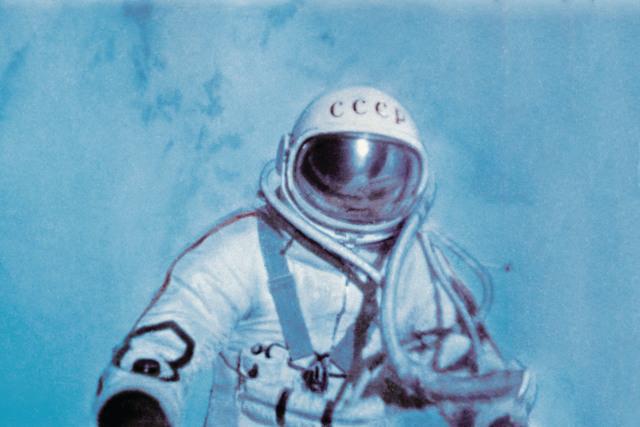
The first space suits for cosmonauts were named SK-1. They were based on the Vorkuta high-altitude suit, designed for pilots of the SU-9 fighter-interceptor. Only the helmet was completely reconstructed. A mechanism was installed in it, which was controlled by a special sensor. With a drop in pressure in the suit, the transparent visor instantly slammed shut.
Equipment for astronauts was made to measure. For the first flight, it was created for those who showed the best level of training. This is the top three, which included Yuri Gagarin and Grigory Nelyubov.
It is interesting that the astronauts went into space later than the spacesuit. One of the special suits of the SK-1 brand was sent into orbit during two test unmanned launches of the Vostok spacecraft, which took place in March 1961. In addition to the experimental mongrels, there was an Ivan Ivanovich mannequin dressed in a spacesuit on board. A cage with guinea pigs and mice was installed in the chest of this artificial person. And in order to prevent casual witnesses of the landing from mistaking "Ivan Ivanovich" for an alien, a sign with the inscription "Layout" was placed under the visor of his spacesuit.
The SK-1 suits were used during five manned flights of the Vostok spacecraft. However, female astronauts could not fly in them. For them, the SK-2 model was created. For the first time, it found its application during the flight of the Vostok-6 spacecraft. We made this spacesuit, taking into account the structural features of the female body, for Valentina Tereshkova.
Developments of American specialists
In the implementation of the Mercury program, US designers followed the path of Soviet engineers, while making their own proposals. So, the first American spacesuit took into account the fact that astronauts in space in the future will be longer in orbit.
Designer Russell Colley made a special Navy Mark suit, originally intended for flying by naval pilots. Unlike other models, this suit was flexible and had a relatively small weight. To use this option in space programs, several changes were made to the design, which primarily affected the device of the helmet.
The suits of the Americans proved their reliability. Just once, when the Mercury 4 capsule splashed down and began to sink, the suit nearly killed astronaut Virgil Grisson. The pilot barely managed to get out, as he could not disconnect from the onboard life support system for a long time.
Creation of autonomous suits
Due to the rapid pace, it was necessary to design new special suits. After all, the first models were only emergency rescue. Due to the fact that they were attached to the life support system of a manned spacecraft, astronauts in space could not visit such equipment. To enter open extraterrestrial space, it was necessary to design an autonomous spacesuit. This was done by the designers of the USSR and the USA.
The Americans, under their Gemini space program, created new modifications of the G3C, G4C, and G5C spacesuits. The second of them was designed for spacewalks. Despite the fact that all American spacesuits were connected to the onboard life support system, they had an autonomous device built into them. If necessary, his resources would be enough to support the life of an astronaut for half an hour.

On 06/03/1965, the American Edward White went into outer space in a G4C spacesuit. However, he was not a pioneer. Two and a half months before him, Alexei Leonov visited space next to the ship. For this historic flight, Soviet engineers developed the Berkut spacesuit. It differed from the SK-1 by the presence of a second hermetic shell. In addition, the suit had a shoulder pack equipped with oxygen tanks, and a light filter was built into his helmet.
While in outer space, a man was connected to the ship by a seven-meter halyard, which included a shock-absorbing device, electrical wires, a steel cable and a hose for emergency oxygen supply. The historical exit to extraterrestrial space took place on March 18, 1965. Alexei Leonov was outside 23 minutes. 41 sec.
Suits for the exploration of the moon
After mastering the earth's orbit, man rushed further. And his first goal was the implementation of flights to the moon. But for this, special autonomous spacesuits were needed that would allow them to be outside the ship for several hours. And they were created by the Americans during the development of the Apollo program. These suits provided protection for the astronaut from solar overheating and from micrometeorites. The first developed version of the lunar suits was called A5L. However, later it was improved. In the new modification of the A6L, a heat-insulating shell was provided. The A7L version was a fire resistant variant.
Lunar suits were one-piece multilayer suits with flexible rubber joints. On the cuffs and collar were metal rings designed to attach sealed gloves and a helmet. The suits were fastened with a vertical zipper sewn from the groin to the neck.
The Americans set foot on the surface of the Moon on July 21, 1969. During this flight, the A7L spacesuits found their use.
Soviet cosmonauts were also going to the moon. For this flight, the Krechet spacesuits were created. It was a semi-rigid version of the suit, on the back of which there was a special door. The astronaut had to climb into it, thus dressed in equipment. The door was closed from the inside. For this, a side lever and a complex circuit of cables were provided. Inside the suit was a life support system. Unfortunately, to visit the moon Soviet cosmonauts did not succeed. But the suit created for such flights was later used in the development of other models.
Equipment for the latest ships
Since 1967 Soviet Union Soyuz launched. These were vehicles designed to create orbital stations. The time the cosmonauts spent on them invariably increased.

For flights on the Soyuz spacecraft, the Yastreb spacesuit was made. Its differences from the "Berkut" consisted in the design of the life support system. With its help, the respiratory mixture was circulated inside the spacesuit. Here it was purified from harmful impurities and carbon dioxide, and then cooled.
The new Sokol-K rescue suit was used during the Soyuz-12 flight in September 1973. Even sales representatives from China purchased more advanced models of these protective suits. Interestingly, when the manned spacecraft Shanzhou was launched, the astronauts in it were dressed in equipment very reminiscent of the Russian model.
For spacewalks, Soviet designers created the Orlan spacesuit. This is a self-contained semi-rigid equipment, similar to the lunar Gyrfalcon. It was also necessary to dress in it through the door in the back. But, unlike the Krechet, the Orlan was universal. Its sleeves and trouser legs are easily adjusted to the desired height.
Not only Russian cosmonauts flew in Orlan spacesuits. Based on the model of this equipment, the Chinese made their Feitian. In them, they went into outer space.
Suits of the future
Today, NASA is developing new space programs. They include flights to asteroids, to the Moon, and also. That is why the development of new modifications of spacesuits continues, which in the future will have to combine all the positive qualities of a working suit and rescue equipment. On which option the developers will stop is still unknown.

Maybe it will be a heavy hard suit that protects a person from all negative external influences, or maybe modern technologies will allow you to create a universal shell, the elegance of which will be appreciated by future female astronauts.
You should start with the very definition of the word spacesuit, which literally translates from ancient Greek as “a ship of a man” or “a boat-man”. The first to use this word, in the sense we know, was the French abbot and mathematician La Chapelle to describe the costume he developed. The mentioned suit was an analogue of a diving one and was intended for a comfortable crossing of soldiers across the river. Somewhat later, aviation spacesuits for pilots were created, the purpose of which is to ensure the rescue of the pilot in case of cabin depressurization and during ejection. With the beginning of the space age, a new type of space suit was formed - space.

The space suit of the first cosmonaut ("SK-1") - Yuri Gagarin, was designed just on the basis of the Vorkuta aviation suit. The SK-1 was a soft type of suit that consisted of two layers: thermoplastic and sealed rubber. The outer layer of the spacesuit was covered in an orange cover, for more convenient search work. In addition, heat-protective overalls were worn under the spacesuit. Pipelines were attached to the latter, the task of which was to ventilate the suit, remove moisture and carbon dioxide emitted by a person. Ventilation took place with the help of a special hose connected to the suit inside the cabin. Also, "SK-1" had a so-called assynthesizing device - something like elastic shorts with replaceable absorbent pads.
The main purpose of such a spacesuit is to protect the astronaut from the harmful effects of the environment in an emergency. Therefore, during depressurization, the ventilation hose was instantly cut off, the helmet visor was lowered and the supply of air and oxygen from the cylinders was started. During normal operation of the ship, the time of the suit was about 12 days. In case of depressurization or malfunction of the life support system (LSS) - 5 hours.
Modern space suit
There are two main types of space suits: hard and soft. And if the first can accommodate the impressive functionality of the life support system and additional protective layers, then the second is less bulky and significantly increases the maneuverability of the astronaut.
By the time of the first human spacewalk (Aleksey Leonov), space suits were divided into three more types: for rescue in case of an emergency, for work in outer space (autonomous), and also universal.
The basic model of the Russian spacesuit without spacewalk is the Sokol, the American ACES. The first Sokol model entered service in 1973 and is worn by cosmonauts during every Soyuz flight.
"Falcon"

The design of the modern version of the spacesuit ("SOKOL KV-2") includes two glued layers: power - outside, and sealed - inside. Pipelines for ventilation are connected to the containment. The pipeline for supplying oxygen is connected only to the helmet of the suit. The dimensions of the spacesuit depend directly on the parameters human body, but they have requirements for an astronaut: height 161-182 cm, chest girth - 96-108 cm. In general, there were no significant innovations in this model and the spacesuit perfectly copes with the goal - maintaining the safety of the astronaut during space transportation.
"Orlan-MK"
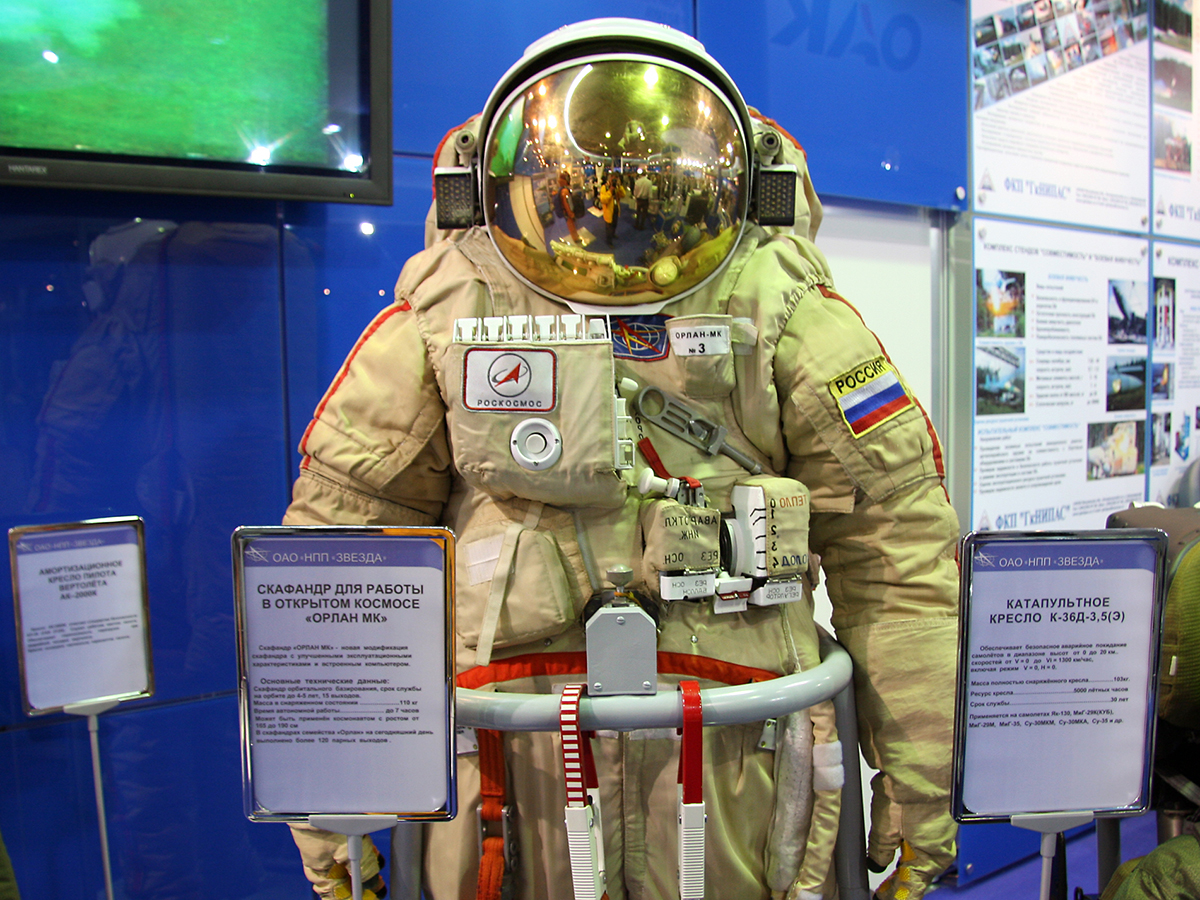
Soviet space suit designed for work in open space. The MK model has been used on the ISS since 2009. This suit is self-contained and capable of supporting safe work astronaut in outer space for seven hours. The Orlan-MK design includes a small computer that allows you to see the status of all spacesuit systems during extravehicular activity (EVA), as well as recommendations in case of malfunctions of any of the systems. The helmet of the suit has a gold plating to reduce the harmful effects of sunlight. It is worth noting that the helmet even has a special system for purging the ears, which are laid when the pressure inside the spacesuit changes. The satchel, located behind the suit, contains the oxygen supply mechanism. The weight of "Orlan-MK" is 114 kg. Working time outside the ship - 7 hours.
The cost of such a suit can only be assumed: in the range from 500 thousand dollars to 1.5 million dollars.
A7L
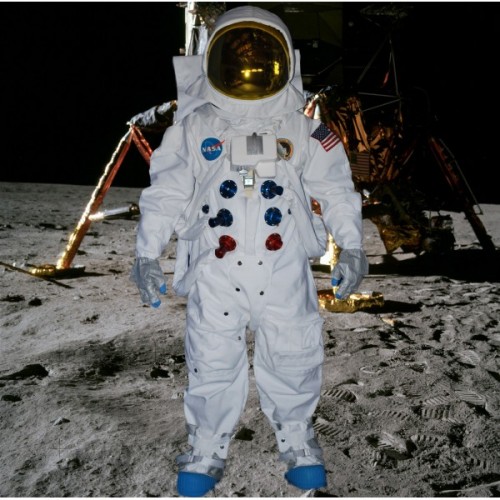
The real test for spacesuit developers began from the moment preparations began for landing astronauts on the moon. To accomplish the task, the A7L spacesuit was developed. Briefly speaking about the design of this suit, several features should be mentioned. "A7L" consisted of five layers, had thermal insulation. The inner pressure suit had several connectors for LSS, the outer durable shell included two layers: anti-meteor and fire-resistant. The shell itself was made from 30 different materials to ensure the aforementioned characteristics. A notable component of the "A7L" was a backpack worn on the back, which contained the main components of the LSS. It is noteworthy that in order to avoid overheating of the astronaut, as well as fogging of the pressure helmet, water circulated inside the spacesuit, which transferred the heat generated by the human body. The heated water entered the knapsack, where it was cooled by means of a sublimation refrigerator.
"EMU"
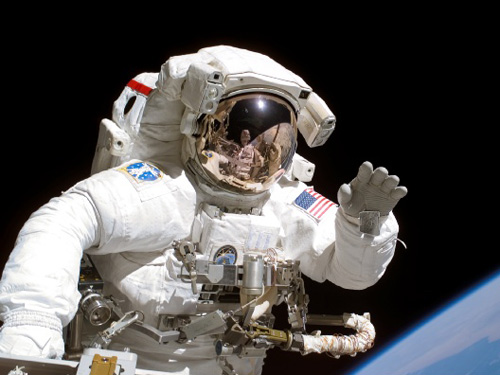 The Extravehicular Mobility Unit or "EMU" is an American extravehicular suit that, along with the Orlan-MK, is used by astronauts for spacewalks. It is a semi-rigid suit, for the most part similar to the Russian design. Some of the differences include:
The Extravehicular Mobility Unit or "EMU" is an American extravehicular suit that, along with the Orlan-MK, is used by astronauts for spacewalks. It is a semi-rigid suit, for the most part similar to the Russian design. Some of the differences include:
- A liter container of water connected by a tube to the helmet;
- Reinforced housing capable of withstanding temperatures ranging from -184°C to +149°C;
- Working time in outer space - 8 hours;
- A slightly lower pressure inside the spacesuit - 0.3 atm., While the "Orlan MK" - 0.4 atm.;
- There is a video camera;
- The presence of the above features affected the weight of the suit, which is about 145 kg.
The cost of one such suit is $12 million.
Clothing of the astronauts of the future

Looking not far, let's say about the commissioning of a new modification of the Orlan-MKS spacesuit in 2016. The main features of this model are automatic thermoregulation, depending on the complexity of the work performed by the cosmonaut at the moment, and automation of the preparation of the spacesuit for performing a spacewalk.
NASA is also developing new space suits. One of these prototypes is already being tested - "Z-1". Although the Z-1 looks very similar to Buzz Lightyear's spacesuit from Toy Story, its functionality has some significant innovations:
- The presence of a universal port in the back of the suit will allow you to connect to it both an autonomous LSS, in the form of a knapsack, and a life support system provided by the ship;
- The increased mobility of an astronaut in a spacesuit is achieved due to: a new technology of "inserts" in the places of bending of body parts, a soft design of the suit, as well as a relatively low weight - about 73 kg, in the assembly for EVA. The mobility of an astronaut in Z-1 is so high that it allows him to bend down and reach his toes, kneel, or even sit in a position similar to the lotus position.
But problems arose with the Z-1 already at the initial stages - its bulkiness does not allow astronauts to be in it on board some spacecraft. Therefore, NASA, in addition to the "Z-1" and the already announced modification - "Z-2", reports on the work on another prototype, the features of which have not yet been disclosed.
It should be noted that in this area there are also innovative bold proposals, the most famous of which is “Biosuit”. Deva Newman is a professor of aeronautics at one of the best universities mira (MIT) has been working on the concept of such a suit for over 10 years. A feature of Biosuit is the absence of empty space in the suit for filling it with gases in order to create external pressure on the body. The latter is produced mechanically using an alloy of titanium and nickel, as well as polymers. That is, the spacesuit itself is pulled together, creating pressure on the body. Being divided into segments, "Biosuit" is "not afraid" of spacesuit punctures in one place or another, since the puncture site will not lead to depressurization of the entire suit, and can simply be sealed. In addition, this technology will significantly reduce the weight of the suit and prevent astronaut injuries resulting from working in a heavy suit. What remains in the development process is a helmet, which, unfortunately, most likely will not be possible to create using this technology. And therefore, probably, in the future, a certain symbiosis of the Biosuit and EMU suits awaits us.
Summing up, I would like to note that the rapid development of technology leads to an equally rapid development of space technology, tools and equipment. Financing can only be a brake factor in the development of spacesuits, since this equipment costs millions of dollars.






